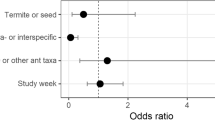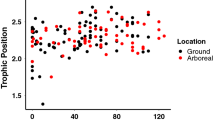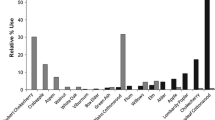Abstract
Many potential species invasions fail before establishment. This is likely especially true for invasive Argentine ants that must overcome a severe founding bottleneck and transition from propagules that rely on protein-rich prey to massive supercolonies that dominate by consuming carbohydrate-rich honeydew from hemipteran mutualists. While this dietary shift supports the classic idea that protein fuels early colony development and carbohydrates maintain adult workers, recent evidence suggests that carbohydrates can govern initial colony establishment. In this study, we use lab experiments to show that resources from aphid mutualists had greater benefits for Argentine ant propagule survival, maintenance, growth, and worker activity rates than did prey items. These effects persisted at low aphid densities, and when colonies were otherwise starved. Moreover, prey-starved colonies did not appear to consume aphids, suggesting that carbohydrate-rich honeydew is a mechanism that facilitates colony establishment. Combined, these results support a hypothesis that the dietary shift from prey to honeydew is driven more by increased access to hemipterans after establishment, than by specific benefits of prey early in colony development. The results highlight the important role of nutritional ecology for studying invasive establishment, linking propagule success not only to the supply of food resources, but also to their quality.




Similar content being viewed by others
References
Abbot KL, Green PT (2007) Collapse of an ant–scale mutualism in a rainforest on Christmas Island. Oikos 116:1238–1246
Aron S, Keller L, Passera L (2001) Role of resource availability on sex, caste, and reproductive allocation ratios in the Argentine ant Linepithema humile. J Anim Ecol 70:831–839
Bond W, Slingsby P (1984) Collapse of an ant-plant mutualism: the Argentine ant (Iridomyrmex humilis) and myrmecochorous Proteaceae. Ecology 65:1031–1037
Brightwell RJ, Silverman J (2011) The Argentine ant persists through unfavourable winters via mutualism facilitated by a native tree. Environ Entomol 40:1019–1026
Bronstein JL (1994) Conditional outcomes in mutualistic interactions. Trends Ecol Evol 9:214–217
Christian CE (2001) Consequences of a biological invasion reveal the importance of mutualism for plant communities. Nature 413:635–639
Cushman JH, Whitham TG (1991) Competition mediating the outcome of a mutualism—protective services of ants as a limiting resource for membracids. Am Nat 138:851–865
Dussutour A, Simpson SJ (2009) Communal nutrition in ants. Curr Biol 19:740–744
Frederickson ME (2006) The reproductive phenology of an Amazonian ant species reflects the seasonal availability of its nest sites. Oecologia 149:418–427
Gaigher R, Samways MJ, Henwood J, Jolliffe K (2011) Impact of a mutualism between an invasive ant and honeydew-producing insects on a functionally important tree on a tropical island. Biol Invasions 13:1717–1721
Giraud T, Pedersen JS, Keller L (2002) Evolution of supercolonies: the Argentine ants of southern Europe. Proc Natl Acad Sci USA 99:6075–6079
Grover CD, Kay AD, Monson JA, Marsh TC, Holway DA (2007) Linking nutrition and behavioural dominance: carbohydrate scarcity limits aggression and activity in Argentine ants. Proc R Soc B 274:2951–2957
Hee J, Holway DA, Suarez AV, Case TJ (2000) Role of propagule size in the success of incipient colonies of the invasive Argentine ant. Cons Biol 14:559–563
Helms KR, Vinson SB (2002) Widespread association of the invasive ant Solenopsis invicta with an invasive mealybug. Ecology 83:2425–2438
Helms KR, Vinson SB (2008) Plant resources and colony growth in an invasive ant: the importance of honey-dew producing Hemiptera in carbohydrate transfer across trophic levels. Environ Entomol 37:487–493
Holway DA (1999) Competitive mechanisms underlying the displacement of native ants by the invasive Argentine ant. Ecology 80:238–251
Holway DA, Suarez AV, Case TJ (1998) Loss of intraspecific aggression in the success of a widespread invasive social insect. Science 282:949–952
Holway DA, Lach L, Suarez AV, Tsutsui ND, Case TJ (2002) The causes and consequences of ant invasions. Ann Rev Ecol Systemat 33:181–233
Johnson RA, Gibbs AG (2004) Effect of mating stage on water balance, cuticular hydrocarbons and metabolism in the desert harvester ant, Pogonomyrmex barbatus. J Ins Physiol 50:943–953
Kay AD, Scott SE, Schade JD, Hobbie SE (2004) Stoichiometric relations in an ant–treehopper mutualism. Ecol Lett 7:1024–1028
Kay AD, Zumbusch TB, Heinen JL, Marsh TC, Holway DA (2010) Nutrition and interference competition have interactive effects on the behavior and performance of Argentine ants. Ecology 91:57–64
Le Breton J, Jourdan H, Chazeau J, Orivel J, Dejean A (2005) Niche opportunity and ant invasion: the case of Wasmannia auropunctata in a New Caledonian rain forest. J Trop Ecol 21:93–98
Macom TE, Porter SD (1995) Food and energy requirements of laboratory fire ant colonies (Hymenoptera: Formicidae). Environ Entomol 24:387–391
Markin GP (1970) Foraging behavior of the Argentine ant in a California citrus grove. J Econ Entomol 63:740–744
Mondor EB, Rosenheim JA, Addicott JF (2008) Mutualist-induced transgenerational polyphenisms in cotton aphid populations. Funct Ecol 22:157–162
Newell W, Barber TC (1913) The Argentine ant. US Dept Agric Bur Entomol Bull 122:1–98
O’Dowd DJ, Green PT, Lake PS (2003) Invasional ‘meltdown’ on an oceanic island. Ecol Lett 6:812–817
Oliver TH, Leather SR, Cook JM (2008) Macroevolutionary patterns in the origin of mutualisms involving ants. J Evol Biol 21:1597–1608
Oster GF, Wilson EO (1978) Caste and ecology in the social insects. Princeton University Press, Princeton
Palmer TM, Doak DF, Stanton ML, Bronstein JL, Kiers ET, Young TP, Goheen JR, Pringle RM (2010) Synergy of multiple partners, including freeloaders increases host fitness in a multispecies mutualism. Proc Natl Acad Sci 107:17234–17239
Pontin AJ (1960) Field experiments on colony foundation by Lasius niger and L. flavus (F.) (Hym., Formicidae). Ins Soc 7:227–230
Powell BE, Silverman J (2010) Population growth of Aphis gossypii and Myzus persicae (Hemiptera: Aphididae) in the presence of Linepithema humile and Tapinoma sessile (Hymenoptera: Formicidae). Environ Entomol 39:1492–1499
Rodriguez-Cabal MA, Stubel KL, Nunez MA, Sanders NJ (2009) Quantitative analysis of the effects of the exotic Argentine ant on seed-dispersal mutualisms. Biol Lett 5:499–502
Rowles AD, Silverman J (2009) Carbohydrate supply limits invasion of natural communities by Argentine ants. Oecologia 161:161–171
Sagata K, Lester PJ (2009) Behavioural plasticity associated with propagule size, resources, and the invasion success of the Argentine ant Linepithema humile. J Appl Ecol 46:19–27
Sanders NJ, Gotelli NJ, Heller NE, Gordon DM (2003) Community disassembly by an invasive species. Proc Natl Acad Sci 100:2474–2477
Simberloff D (2009) The role of propagule pressure in biological invasions. Annu Rev Ecol Syst 40:81–102
Sorensen AA, Vinson SB (1981) Quantitative food distribution studies within laboratory colonies of the imported fire ant, Solenopsis invicta Buren. Ins Soc 28:129–160
Stadler B, Dixon AFG (2005) Ecology and evolution of aphid-ant interactions. Ann Rev Ecol Evol Systemat 36:345–372
Suarez AV, Holway DA, Liang D, Tsutsui ND, Case TJ (2002) Spatiotemporal patterns in intraspecific aggression in the invasive Argentine ant. Anim Behav 64:697–708
Tillberg CV, Holway DA, LeBrun EG, Suarez AV (2007) Trophic ecology of invasive Argentine ants in their native and introduced ranges. Proc Natl Acad Sci 104:20856–20861
Toft S (1995) Value of the aphid Rhopalosiphum padi as food for cereal spiders. J Appl Ecol 32:552–560
Tschinkel WR (1992) Brood raiding and the population dynamics of founding and incipient colonies of the fire ant, Solenopsis invicta. Ecol Entomol 17:179–188
Tsutsui ND, Suarez AV, Grosberg RK (2003) Genetic diversity, asymmetrical aggression, and cooperation in a widespread invasive species. Proc Natl Acad Sci 100:1078–1083
Vogt JT, Appel AG, West MS (2000) Flight energetics and dispersal capability of the fire ant, Solenopsis Invicta Buren. J Ins Physiol 46:697–707
Walters AC, MacKay DA (2005) Importance of large colony size for successful invasion by Argentine ants (Hymenoptera: Formicidae): evidence for biotic resistance by native ants. Aust Ecol 30:395–406
Wilder SM, Holway DA, Suarez AV, Eubanks MD (2011) Macronutrient content of plant-based food affects growth of a carnivorous arthropod. Ecology 92:325–332
Yao I, Akimoto S (2002) Flexibility in the composition and concentration of amino acids in honeydew of the drepanosiphid aphid Tuberculatus quercicola. Ecol Entomol 27:745–752
Acknowledgments
We thank A. D. Kay and B. Guenard for critical readings of this manuscript. Support for this research came from the Blanton J. Whitmire endowment at North Carolina State University. M Green assisted with monitoring this experiment. E Spicer-Rice assisted in the field. Experiments comply with all laws of the USA.
Author information
Authors and Affiliations
Corresponding author
Electronic supplementary material
Below is the link to the electronic supplementary material.
Rights and permissions
About this article
Cite this article
Shik, J.Z., Silverman, J. Towards a nutritional ecology of invasive establishment: aphid mutualists provide better fuel for incipient Argentine ant colonies than insect prey. Biol Invasions 15, 829–836 (2013). https://doi.org/10.1007/s10530-012-0330-x
Received:
Accepted:
Published:
Issue Date:
DOI: https://doi.org/10.1007/s10530-012-0330-x




